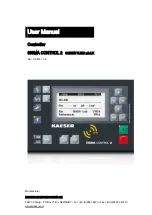
iSMA-B-AAC20/Sedona Modbus
Version 1.3
www.gc5.pl
Page 40 / 55
6.4
Modbus RS 485 Slave Device (COM1)
iSMA-B- AAC20 controller can be also Slave Device working on RS485 bus connection. To
connect iSMA-B-AAC20 controller to RS485 bus you must use Com1 port with RJ12
connector. RJ12 connector is located between SD card and USB slot. The Modbus RS485
Slave use the same Modbus table as Modbus TCP Slave. From addresses from 0
–
999
(decimal) you can read controller specified data (see Modbus iSMA-B-AAC20 table chapter)
and at 1000
–
2999 address range you can add user values by placing data components under
ModbusTcpSlaveNetwork (see Modbus TCP Data points chapter).
WARNING! This port is always enable and is ready to use after power up. It can be also used
by Sedona Updater software (action, file sending) without turning device to bootloader mode.
It also cooperate with iSMA devices (MINI and MIX IP series) Modbus IP/RS485 gateway
function. From software side controller is shown as an IP device.
COM1 default settings:
Modbus Address
–
1 (register number
–
2 Dec.),
Baud Rate
–
115200 (value 11520, register number
–
135 Dec.),
Stop Bits
–
1 (register number
–
136 Dec.),
Data Bits
–
8 (register number
–
137 Dec.),
Parity bits
–
None (register number
–
138 Dec.),
Response Delay
–
0 (register number
–
139 Dec.),
Modbus Protocol Type - RTU (value 0, register number
–
141 Dec.).
6.4.1
Modbus Slave COM1 wiring
WARNING! This port can only work in slave mode and it is not possible to run it in master
mode.
To read controller Modbus table by RS485 bus it is necessary to use COM1 port. The port is
implemented by RJ12 connector located between SD card and USB slot. The connector
provides Modbus bus wires, ground potential G0, and power supply directly connected to G
terminal from power supply connector (this option will be used in future to supply Sedona
panels). Wiring diagram is shown in Figure bellow.
















































